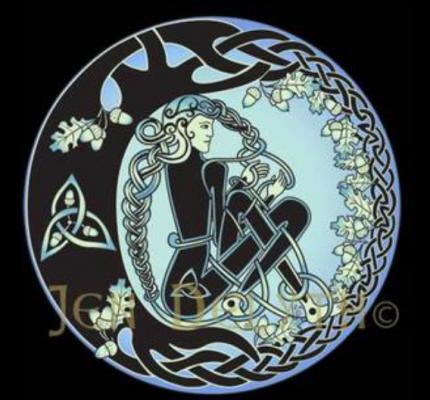
A few nights ago, as we walked east along the path between the garden and the sheep field, we looked into the indigo sky, where the nearly full moon was an immense and glowing disc just above the ridge. In the morning, after its night journey, the moon hovered, an orange ball, over the opposite horizon. Moments and sights like these herald a renewed recognition that we are in a thin time.
Easter, the feast of resurrection, is celebrated on the Sunday after that first full moon of the spring equinox. It is the highest of holy days for Christians, the victory feast of the risen One, the ultimate affirmation of life out of death. So here we are at our sunrise fire, which this year, thanks to the moon cycle, we light within the volatile and potent month of March. As it turns out, this holds surprising treasure.
I went to the kitchen for a cup of coffee and my eye fell on our wall calendar, designed by Celtic artist Jen Delyth. It shows March to be a month rich with days honoring the patron saints of the Celtic lands: St. David of Wales, St. Piran of Cornwall, and St. Patrick of Ireland....a month permeated with holiness. The calendar's artwork for March features a dryad sitting within an oak tree.
It has this note:
The Celtic Tree of Life symbolizes the mysticism of the Old Religion, in which the trees, the creatures, and the land are a strong and vital force, connecting the folk within a living universe...The oak is particularly revered by the Druids, whose name is related to duir , the Celtic word for "oak" and "door"--the opening to the Mysteries, and the dryads are the wood nymphs of Greek mythology, the Spirits of the Oak Tree.
Right there on March 27 is Easter, the feast of the resurrection of Jesus, nestled luminously within this wild month of March, entwined in a world in which the forest and wild spaces and all their inhabitants form a vital connection with a living universe; a place peppered with thresholds and doors to mystery and a renewed sense of wonder and belonging.
The picture of the dryad, the spirit of the oak tree, triggered happy memories of reading C.S. Lewis' stories of Narnia. How I loved those tales of the magical place beyond the wardrobe and the lamppost, populated not only with dryads, but also fauns, centaurs, dwarves and animals who spoke to the human children, guiding and teaching them.
C.S. Lewis did not set out to write a Christian allegory. The thought that he planned it that way was he said, "pure moonshine... It all began with images; a faun carrying an umbrella, a queen on a sledge, a magnificent lion. At first there wasn't anything Christian about them; that element pushed itself in of its own accord."
The Lion, the Witch, and the Wardrobe is not an allegory; but there is no denying that the "Christian element" as Lewis said, is there: a mighty, holy and gentle being who lays down his life willingly for an apparently unworthy other--a traitor--and who through the power of Love is resurrected; and whose transformation in turn changes for ever all those who love him. Enbedded utterly plausibly in the nature-based, wonder-filled, and wild world of Narnia is this keystone Christian story. Note that Aslan, the Christ, is himself a wild one, as the beavers tell the children: "Safe?" said Mr. Beaver: "don't you hear what Mrs. Beaver tells you? Who said anything about safe? Course he isn't safe. But he's good..." and later, "He's wild you know. Not like a tame lion."
As the sun comes up over the ridge and our wild acres here at Rolling Ridge are lit with primal fire on the morning of the holiest feast of the Christian year, the Feast of the Resurrection, it is good to be reminded of the deep, unconfined resonance of the sacred. Dryads, oak trees, magnificent Lions, full moons, doors that open to mystery, and Celtic saints, empty tombs, and the Risen Christ and Easter morning all dance together in this rich and tumbled month of March. May it always be so. Amen.
Image Credit: "Dryad - spirit of the oak tree" by Jen Delyth © www.celticartstudio.com